1974 Horror: Blood, Guts, and Chainsaws
This Halloween season, The Signal looks at the most Horrific films that bled onto the screen 50 years ago...
For the last year I have watched as many horror films from 1974 as I could (celebrating their 50th anniversary of release). There were about 150ish that I knew were produced. And besides a handful I could not find and those foreign horror films that I could not locate with added English subtitles1, I got through most of them. I did a lot of watching in the deep night when the kids were sleeping and the quiet darkness uplifted the rich 70s coloring of the films. I watched enough to get a sense of what 1974 horror was as a moment in time for the genre…what it meant…the themes that were explored within the gore and scare. And while 1974 was more of a transition year, there was definitely a huge huge huge highlight, some interesting occurrences that are worth digging into…as well as some films that every horror movie fan should check out.
1974 was the year that horror got introspective, that horror writers and directors started to look back sentimentally at the history of the genre, celebrate and contemplate it. In the beautiful film The Spirit of the Beehive, the Universal Frankenstein film is shown in a small village, deeply impacting Ana, a little girl, who goes on to have adventures by imagining the world around her as that of the monster’s in the film. The end of the film virtually recreates the famous scene of Frankenstein’s monster playing with the little girl he finds picking flowers (before throwing her in the lake), with Ana being the little girl in this version. Mel Brookes had a huge hit in 1974 with Young Frankenstein, a hilarious love letter to the original Frankenstein film and sequel, where he wrote characters who wrestled with the past in the most riotous manner, often being the children of the characters in the original, and even used the original laboratory set to make the monster come to life. Clive Donner was less successful with his film Vampira (also called Old Dracula) that tried to do for Dracula what Brookes did for Frankenstein, with David Niven playing the vampire for non-laughs in this forgettable exercise. And finally, there was Madhouse, where, in between murders, an old horror movie actor, played by Vincent Price, looks back ala Sunset Boulevard on his career which includes actual older Vincent Price horror movie scenes.
With the massive success of the Exorcist in 1973, there were a slew of rip off films…most of them duds…but nevertheless showcasing an interesting phenomenon. These films included: The Abby, The Anitchrist (from Italy, including an above average Ennio Morricone score), Voodoo Black Exorcist (from Spain), Exorcismo (also from Spain), The Bloody Exorcism of Coffin Joe (from Brazil), Lorna the Exorcist, Beyond The Door, The Devil’s Female (sleaze from Germany), Enter The Devil (sleaze from Italy) and even the porn-horror The Sexorcist directed by Ray Dennis Steckler, one of the great underground filmmakers of the 1960s, merging a somewhat-plot about a reporter researching a tribal occult (which has resemblances to past Steckler goodness) with a truly rank nudie which must have been shot somewhere in Studio City. But of all the Exorcist rip-offs, Seytan is the craziest, coming out of Turkey where The Exorcist was not distributed. The film is a virtual shot-for-shot copy of the William Friedkin film…although not close to being as good…which can be witnessed in this youtube comparison of the two.
For a year dominated by Exorcisty films, a year that witnessed the final breaths of Hammer’s dominance of the genre yet before the rise of the Italian and American horror scene, a film was released that immediately reimagined what a horror movie could be, and thus began to set the stage for what was to come. The Texas Chainsaw Massacre is one of the greatest horror films of all time; The Texas Chainsaw Massacre is one of the greatest films of all time. Called “a perfect film” by Quentin Tarantino, from beginning to end director Tobe Hooper tells an incredible story—a family story (!?)—that from the onset is eerie and uncomfortable and dives deeper and deeper into dark, scary, root-of-evil horror at its best. There are so many scenes that are scarring and brutal, still angry after all these years. So many classic fear factor scenes, like the cutting of Franklin by the hitchhiker…the first pall peen hammer bludgeoned body-convulsing death…the meat hook scene (oh, the meat hook scene)…the opening of the deep freeze scene…the family dinner scene complete with grandpa the killer…the quiet moment where Leatherface looks out of his window, licking his rotted teeth…and the first moment we hear that chainsaw whirl. There might not be that much gore in the film, but Hooper is masterful at taking us into the depths of hell without it. Big learning here: DON’T GO INTO SOMEONE’S HOUSE WITHOUT BEING INVITED! Yes, we find out that Leatherface hunts the forest anyway (sorry, Franklin) but the group of kids would have had a better chance if they had just stayed out of the damn house. Inspired by the true crimes of Ed Gein and Elmer Wayne Henley, The Texas Chainsaw Massacre ripped open the darkness of the United States during the time of Watergate and distrust and fear with a chaotic nihilistic vision of unrepentant evil.
Let’s dig into the year’s best horror films (with Texas Chainsaw the understood winner). Filmmaker, friend and horror enthusiast Jeremy Solterbeck has generously given his thoughts on a few films from 1974 and you will find his sterling commentary farther down in this newsletter. But first, here are some specific highlights from the class of 1974:
Most Prolific Actor: Peter Cushing. When Peter Cushing’s wife Hélène Beck died in 1971, he threw himself into his work. As a top horror actor of his time, he was welcomed into the casts of many films. Cushing appears in 6 horror films in 1974, three good ones (see below), two incredibly awful ones (The Big Scare, The Beast Must Die) and in a decent short that is part of a fairly inauspicious horror anthology (From Beyond the Grave).
Most Unexpected Moment: The Big Scare (or Tendre Dracula): When the two women Héloïse and Marie (played by Alida Valli and Miou-Miou), who are staying the evening with Peter Cushing’s MacGregor to see if he is an actor playing a vampire or a vampire playing an actor, in a moment of playful nudity, during downtime in between killings, burst into song, performing a musical number—which is badly overdubbed as well.
Best Soundtrack: The Bloody Exorcism of Coffin Joe (Geraldo José), Legacy of Satan (Arlon Ober & Mel Zelniker), Evil of Dracula (Riichirô Manabe), Lisa Lisa (George Newman Shaw & John Willhelm).
Hardest-to-watch moment: There are two, actually, both from Flavia: Heretic Priestess. The first: the horse castration scene (uugghhhh)(no animals…we hope…were hurt while filming). The second: when Flavia gets skinned alive. Yes, a spoiler. Not a great film…so: you are welcome.
Best Special Guests: Leif Garrett and Sorrell Booke in People Toys (or Devil Times Five): This otherwise very boring and very very bad film features a very very very young Leif Garrett, whose character takes out everyone’s favorite Dukes of Hazzard Boss (Hogg) with an axe to the head.
And now, for the rest of the best of 1974:
The Bloody Exorcism of Coffin Joe
Not included as one of the “Coffin Joe” trilogy that made the character the Freddie Kruger of Brazil, this installment might be my favorite, with the first two-thirds of the film displaying beautifully done tense, fearful and at times grotesque scenes, leading to the final batshit crazy chapter featuring an unexpected ramp-up of seriously demented cultish gore (Herschell Gordon Lewis style). Devil worshiping, twisted possessions (some of the best of the lot of big screen possessions of ‘74), dark voodoo witchery, and even a subplot that delves into the questions surrounding creation, art and the artist. Includes one of the best soundtracks of the year by Geraldo José.
When a Canadian drive-in movie owner decided to make a horror film to show in his drive-in…for $36,000…he ended up producing a truly rank gore-fest, another that would make Herschell Gordon Lewis proud. A mixture of long, drawn out decadently badly acted lulls to the bloody, dark and disgusting zombie kill scenes, Corpse Eaters is a must for anyone who likes classic b-amateur zombie shlock. Supposedly some of the goriest scenes had been cut out, with the whole film sitting currently unavailable in the Library and Archives of Canada.
The Legend of the 7 Golden Vampires
Amongst horror movie aficionados, this is one of the more loved films from 1974. As the Hammer horror machine looked for a bump during their decent from popularity, they decided to take their most popular franchise and Brady Bunch to Hong Kong, giving it a little karate twist. Christopher Lee declined reprising his role of Dracula for a script he thought was below him. He tried to talk Peter Cushing, his on-screen nemesis Van Helsing and his off-screen best friend, not to sign up either, but Cushing decided to jump in, thinking it would help his grieving process. The result: a crazy, strange Indiana Jones type of adventure through Hong Kong in search of the horrific 7 Golden Vampires. Cheeseball maybe…with a lot of choreographed fight scenes a la Bruce Lee…but still vampire horror at its core and a strange but fun nearing-the-last gasp for Hammer. The 7 Golden Vampires themselves are terrifyingly ugly and bizarre…right up there with the Knights of the Blind Dead (whose 1974 film The Ghost Galleon is a snoooooooze…even though it is ALWAYS cool to see those cloaked skeletons gather for a kill).
The winner of the out-of-control-nutso, biggest-influence-on-Blood-Sucking-Freaks film goes to Help Me…I’m Possessed. I am still not exactly sure how the name fits the movie…except for the fact that the actors are possessed with a lack of talent or that the film is possessed with figuring out different crazy ways to kill off the inmates. Bill Greer, in his—understandably—sole acting role (his success came from producing Charles In Charge) as Dr. Arthur Blackwood, seemingly runs the asylum on the up-and-up but has a big bad masochistic secret, a secret he shares with his whip-whipping-hunchbacked henchman played by Pierre Agostino (who would go on to star in many rank horror flix); tis a screaming-mad wayyyyy-b torture/lunatic-asylum story that is one of the best of this ultra-niche genre.
One of the more famous horror flicks from 1974, this bigger-budget Warner Bros. production features the best creature of the year…a satanic baby who, as it turns out, only its parents could love…at least from the onset by mom. Dad had to shoot the kid once after baby bloodily mangled the neighbor before he realized that sonny needed a hug. But regardless, baby comes out of the womb killing everyone in the birthing room (except mommy) and does what is expected: hunts for milk viciously ripping apart anyone it meets on the way, eventually figuring out where its parents live. The plot is absurd, but is very watchable, and includes a study on the social and professional downfall of parents who have a problematic child. The film’s dramatic ending through underground waterways seems a hat-tip to The Third Man sewer chase scene. The evil, fanged baby looks incredible…one of the year’s best monsters…and initiates some great kill. And if you are wondering: no one ever wonders how the baby came into being. It is just one of those Darwinian evolutions, I guess.
Blood For Dracula follows the previous year’s Flesh For Frankenstein as far as Andy Warhol-produced Paul Morrissey2-directed horror films. As Warhol used his canvas to explore brands like Tomato Soup or Marilyn Monroe, his films did the same while also testing his audience’s endurance (Empire is an 8+ hour film of a static single camera shot of the Empire State Building) and challenging them as to what was acceptable (Blow Job is a 27+ minute film that is relatively self-explanatory). It seems that the monster archetype is perfect for pushing boundaries, and Dracula in particular for examining sexuality and decadence. The film stars Udo Kier as Count Dracula, who leans into his dark, demented sexuality that is more eluded to in most Dracula pictures that come before. Oh…Dracula’s sexual nature is always present in past films, but no one…no one…sucks the blood out of the victim’s throat like Kier’s Dracula (with such drawn=out climactic intensity) and never is the quest for virgin blood so front and center; the Dracula of this film cannot live on any other type, and proceeds to question his potential victims about their sexual history before deciding to strike. Beware: the film starts out slowwwwwwly, with hour of set-up drama before Kier provides one of the sultriest yet aggressive vampire bites in film history (after that bite, the film presents classic blood-sucking genre celebration). And then there is the ending…which I will not give away except to say it reminded me of the battle between King Arthur and the Black Knight in Monty Python’s The Holy Grail.
Texas Chainsaw Massacre is not the only celebration of cannibalism in 1974 horror, for bleak times call for bleak movies. And while Frightmare is no Texas Chainsaw, it might actually end just a tad bleaker, with a hell of a lot more gore. A couple, she who had been convicted of cannibalism, and he who was an accomplice, are released from n asylum after their sentence is carried out, supposedly ready to be upstanding citizens. Their “known daughter” suspects that not all is really ok, delivering animal brains to them to satisfy her mom’s potential murderous cravings for flesh, while a daughter who is not known to them, who is dating a violent bike gang member…is on an inevitable crash course with savage destiny. Shiela Keith, England’s "Female Boris Karloff" is excellent as the out-of-control human flesh eater. Peter Walker, the king of English slasher films, pours a dark red yarn about a screwed family business complete with fortune telling death traps and power drill murders and dismemberments.
While not a cannibal movie, Deranged covers much of the same Ed Gein territory as Texas Chainsaw with some scenes that are so similar, it is hard to believe both movies were released in the same year with supposedly no influence on each other (it was a year of making masks out of the faces of others). Again, this is not nearly as good of a film as Texas Chainsaw—not as tense, not as overwhelmingly full-on—and vastly different, the biggest difference being that the main character is not the victim but the killer. Roberts Blossom breaths true insanity into the roll with a horror performance of the year (a role that he won over Harvey Keitel and Christopher Walken), elevating the b film into something more special and screwed, with Ezra going from incredulous fool to vicious killer, often within the same scene. Bob Clark, who directed two films on this list, makes a cameo as the photograph of the dead husband of one of Ezra’s victims. Blossom and Les Carson, who plays Tom Sims, the narrator/journalist who in real life broke the Gein story, reunite in A Christmas Story nine years later.
It is incredible how Vincent Price spanned decades of cinema, bringing classic after classic horror performance to the screen. Madhouse is yet another. While not as gory as his previous Dr. Phibes films, Madhouse is a well-paced, amazingly acted, scary and brutal iconic 60s-style horror film from a time that was passing the genre by. Peter Cushing co-stars…and it as if the two actors, one representing the American horror art form the other the English, are battling to see which side of the Atlantic is keeping the scream crown. With Texas Chainsaw being released this year, and the death of the Hammer horror franchise (which at its height Cushing played such a huge part in) the answer seems obvious…
Why is it that there are more than a few great early slasher movies that take place during the Christmas holiday? This is the second of two horror films featured on this list from future-Porky’s director Bob Clark, the second being Deathdream. This is a creepy story of crazed killings in a sorority with a great cast of interesting early-70s character actors including Margot Kidder (Superman), scream queen Olivia Hussey (also famous for Romeo and Juliet), Andrea Martin (SCTV) and Keri Duella (2001, A Space Odyssey). The debased psychotic phone calls and drunken camera work—especially around the gruesome killings—seem to be laying the groundwork for the slasher films to come. And the twist and twisted ending leaves a perfect unsettling feeling. There is no escape from the hidden evils of the world. Classic.
Deathdream (or Dead of Night)
Let’s stick to Bob Clark films for a moment. This time he puts on the silver screen a favorite prometheistic campfire horror story—I remember it as The Monkey’s Paw. The moral of the story is that you should never want a dead friend or relative to come back from the grave. He or she or they might come back as Andy Brooks did, underplayed beautifully by soap-writer Richard Backus, who returns from Vietnam after being declared dead on the battlefield; the initial happy return turns sour as is family is made immediately aware that he is a shell of a human, evil. Loved by his mom, not capable of returning anything except sorrow and destruction (keep the pets away), there is nothing but tragedy in store for Andy and everyone around him as his body and mind dissolve into a monstrous force.
Sugar Hill is a zombie Blacksploitation mobster voodoo picture brought to screen by American International Pictures who had found success in the past producing Blackula and its sequel. Diana "Sugar" Hill’s boyfriend is killed by mobsters and Sugar enlists Haitian voodoo priestess Mama Maitresse, played by Zara Cully, to conjure up zombies to take revenge (Cully found fame as George Jefferson’s mother in The Jeffersons). The big switch-a-roo in Sugar Hill is that the black zombies, brandishing mesmerizing hyperthyroidish silver ping pong eyes, are the antiheroes of this story, battling the evil white mob, raising the moralistic question as to how far one should go when battling true evil, as well as providing a needed metaphor around the civil rights infractions ongoing in the mid-seventies. Don Pedro Colley, another actor to find fame in The Dukes of Hazzard (strange, right?) is excellent as Lord of the Dead Baron Samedi, reminding me of Raymond Johnson’s performance as The Overseer in 1974’s Space is the Place.
One of the first films I watched when embarking on this year’s project, my notes simply say: ZOMBIE CHILDREN with a ZOMBIE seeming to PULL THE PENIS OFF OF A VICTIM! Which of course leads one to wonder: just what is that guy eating in the above picture? In a very strange way, this is an environmentally focused film given that the zombies are products of a radioactive pest control device (which could only be thought up by the DDT generation). But please do not think anything insightful or deep is being suggested here…oh no…this is a stoned-classic gory flesh-eating zombie film. Plain and simple. With a few dirty misunderstood agro-hippies along for the ride who are framed by the pigs for the crazy murders that are going on around them…..
While the last ten years has brought to mass audiences documentary after documentary of insane cult movements that occurred in the US over the last 60 years, in the 1970s, these movements were reflected in numerous fictional Satanic cult horror films, with varying degrees of success. Legacy of Satan is not the best in show…but it is a damn good b-variety directed by Gerard Damiano (Who also directed Deep Throat) complete with bloody ritualistic killings, the torture of innocents, and the always-needed bat-shit crazy ending Satan Cult Togetherness Death Null…all the while wondering what actual mission the cult members are ambitious to actualize (ok….supposedly Lord Fakeesh is being asked for the followers to rule over all dark places. But what does that mean????). Poor Maya…unknowingly chosen to be the new queen to the to the cult leader during a once-in-1000 year moment. This film features the forerunner to the Light Saber with the message that you never…NEVER…relinquish control of it…especially to a beautiful undercover Satanic cult member. This film was initially released as part of a double feature with The Texas Chainsaw Massacre.
This film falls under the shit-kicker-yet-entertaining-if-you-are-into-that-kind-of-thing horror genre as well as the badly-acted-just-the-way-you-want-with-just-enough-blood-to-make-it-worth-it horror genre. If this does not sound like your cup-of-tea: IT ISN’T. And while you have to wait til the end to see the bat monster, prolific film and TV director Jerry Jameson keeps the plot moving throughout, with main actor Stewart Moss going for the gold in the overacting competition whenever the regular mutation convulsions erupt….
Frankenstein and the Monster from Hell
The final chapter in Hammer’s Frankenstein saga, the final time Peter Cushing plays Baron Frankenstein, the final directorial work from Hammer legend Terence Fisher. This story started in 1957 with The Curse of Frankenstein with Cushing debuting his character and Christopher Lee playing the monster, after which Hammer became the gold standard for horror through the 60s and early 70s (Cushing would reprise his role six times) . But by 1974 things were winding down and a new era of horror was beginning…less involved with period drama and more involved in nihilistic gore; England was losing its horror empire. This film is not perfect and the monster is borderline Young Frankenstein humorous, but it is still a great watch, gorier than those that came before it, a nice look at the insanity within the character of The Baron, and a nice curtain call for Cushing, Fisher and Hammer Films.
Frankenstein's Castle of Freaks
Michael Dunn was a character actor afflicted with dwarfism who is best remembered as Dr. Loveless in Wild Wild West as well as the memorable roll as Alexander in the Star Trek episode Plato's Stepchildren (season 3, episode 10). Dunn died in 1973 of complications related to his dwarfism, but not before completing four horror films that were released in 1974, two with Donald Pleasence. The best is Frankenstein’s Castle of Freaks produced and directed by Dick Randall, who also produced the mediocre Girl In Room 2A horror flick during the year. The film tells the road-wary tale of Prof. Frankenstein bringing to life a monster who escapes only to bring trouble to anyone he comes in contact with. There is a second monsterish character thrown into the mix named Ook, played with insane vigor by Italian actor Salvatore Baccaro (who looks more crazy than the somewhat goofy and confused looking Frankenstein monster), who Dunn attempts (and fails) to teach basic civilized principals to while the two bond in a cave. But the real monster of the film is Dr. Frankenstein himself, played by international star Rossano Brazzi, whose madness and drive for self-preservation creates a perfect antagonist for the film. This film is by no means perfect, with some slow moments, but is a worthy entry to Frankenstein lore. If you want more of Michael Dunn, The Mutations (or The Freakmaker) (one of the two with Pleasence) is a worthy watch…
The Japanese Toho Production Company, known for the Godzilla franchise, completes its vampire trilogy with this haunting entry. In what seems to be an attempt to capitalize on the success of Hammer’s Dracula pictures, this film presents total dreamlike moody gothic horror, taking place in a timeless remote boarding school in a timeless dark forest. Professor Shiraki, who is just arriving to take a new position at the school, arrives at the institution and immediately comes in contact with a floating vampire, just to be told later that he must have been hallucinating. But as the movie goes on, girl student after girl student seem to fall into a trance-like spell after being bitten in the chest, and the teacher might be the only one who can figure out what is going on (it becomes fairly obvious who the vampire is). The film features Godzilla-acting veteran Katsuhiko Sasaki as well as Shin Kishida who played The Master of Death in Shogun Assassin.
Gui Yan (Ghost Eyes)
I saw this movie twice. The first time I thought it was alright…the second time: WOW. It clicked. A creature of the undead in the form of an ophthalmologist takes control of his manicurist through the contact lenses he makes for her. While she attempts to fight back, she descends into an unretrievable darkness as her essence is drained. In many ways this film quietly foreshadows aspects of what is to come in horror cinema; with a dark, haunting vibe throughout, ghostly shocks that would be so ever present in films like The Grudge, and with a Hellraiser YOU MUST BRING ME VICTIMS plot line, tragically moving the protagonist into a never-go-back evil reality. Yes, it is a slow starter, but it is worth the investment. A very interesting, unexpected twist on a vampire (maybe…the first depiction of an Energy Vampire)? undead? zombie? film?
AND NOW, SOME EXCELLENT COMMENTARY FROM JEREMY SOLTERBECK…
The Demoniacs (Les Démoniaques)
A tawdry bit of French smut for when you need a reminder of how things used to be. The film begins with each character introduced in a lengthy voiceover while they mug in theatrical closeups. The Captain, Le Boscoe, Paul, and Tina are the Wreckers, luring night sailors too close to a rocky shore in order to feast on the wreckage. Unclear is the actual time period, as we're dealing with pirates costumed in 60s cut denim and velour Breton tops. This film merited no less than three releases, with a 23-minute difference between the shortest and longest. Speaking of minutes, the first 10 feature a pair of distressed young women, several prolonged beatings, a stoning, two rapes, a pistol whipping, and some sort of sex brought on by the ecstasy of all the violence. The Captain and his brigands begin suffering guilty delusions post-murder spree, while carousing at the local watering hole. The film gets interesting somewhere in the second act when something like, I shit you not, Ronald McDonald arrives to take the (deceased?) young women deep into an ancient ruin. Skip ahead several sex scenes, and we find the same women appearing at the tavern, where The Captain and his crew are even more unhinged. The filmmakers seem to be running out of money at this point, as characters begin to have conversations in different rooms, as if the actors are delivering the remainder of their lines in whatever room they are currently in. For the climax the plot traverses into the experimental when unmotivated retributions are doled out and Tina, whose clothes have always flown off at the beginning of every scene, stages her final burlesque. She is ultimately done in by The Captain. The resolution is unclear, but still a few new characters are introduced in the last five minutes (!!) and the final shots could serve as an unreleased Led Zeppelin album cover, so that's worth something.
The film claims to be based on Poe's The Cat and the Canary, a book that doesn't exist - an auspicious start. Laid out like a low rent Agatha Christie novella, it slowly but slowly exposits the premise of Lord Archibald Percibal Marian's untimely demise at the hand of a latex-masked murderer, and the sycophants and miscreants that come to lay claim on his will. The script is surprisingly competent, and what unfolds is a passable series of minor twists and entertaining character sketches. The fun is in watching all the wretches get a tortuous death, and oddities like the fact that the plot features two detectives to unravel the truth, but neither does much more than run into the room seconds after a murder occurs. To its credit, it does have one final twist near the end that I didn't see coming. On a technical note, the film is shot in scope with lighting to match. It's as glorious to look at as most anything from the Technicolor era. The blood is the color of glowing plastic magma, candlelight flickers softly like a dying ray of hope, and the shadows are as heavy as chains scraping through a dungeon.
A hybrid of Frankenstein’s Monster and Pet Sematary, Klaus Kinski is underused as Alex, a bored, jealous doctor who finds himself sequestered at his estranged wife's family manor. He discovers a hidden laboratory where he learns, from his father in law's deranged notes, how to return life to corpses using equipment and electricity. First up is his wife's dead dog, and we're off to the races with a gory re-animation scene. In the process, the curse of forbidden life inexplicably inhabits Alex instead, who goes on a rampage resulting in a murdered peasant family. What ensues is a flip-flopping schedule of sedate home life and homicidal rampaging in the woods that seems to be triggered by Alex's jealous inflammations, prompted by the very real threat of the suave doctor Igor who won't stop dropping by to check on Alex's wife. Also notable are the lack of any makeup effects, as the director uses Kinski's natural expressive madness to represent the unleashed brute. He proves to be his own monster - not a Promethean cautionary tale, but simply a suffering sinner who is tortured by his own monstrous motives. Meanwhile, the authorities happily execute homeless people as suspects in the random murders. Alex eventually lives out his worst impulse by murdering his wife, then lurches toward redemption while trying to defend the last vagrant patsy.
Fabulous. See it. The maestro himself, Saul Bass, in his only feature directorial effort, makes an earnest homage to 2001: A Space Odyssey. Complete with shimmering planetary graphics, experimental camera techniques, and hokey Styrofoam plinths in the desert. Recall at this point it had only been six years since that release, and he would later collaborate as artist on The Shining, so it's no surprise to see a Bass/Kubrick connection here as well. I'm also considering this an early attempt at the "smart thriller," where educated people use their intellect to battle esoteric enemies (in this case, ants who have coalesced into a higher group consciousness to try to kill humans). You can see where youngsters at the time, like JJ Abrams or David Fincher, might absorb the thoughtfulness and authenticity newly possible in the genre and take it to new heights a generation later. James Lesko, who earns his place in the story by "applying game theory to the language of killer whales," plays color to Dr. Ernest Hubbs who was evidently onto the ant situation for years. The only sore spot in the script is Kendra, the lone female character, who is pathetically treated like a mute, feral wood nymph lurking in the adult men's laboratory. It's fun listening to the technical mumbo jumbo that represents their theorizing how to fight the swarming villains. The film also features some truly stellar macro photography that elevates the insects to an emotional level of characterhood. I'm pretty sure many ants were definitely harmed in the making of this film.
HAPPY HALLOWEEN!

I watched them anyway, trying to figure out the plot and if there was something worth considering
This newsletter was published before the news of Paul Morrissey’s death https://www.nytimes.com/2024/10/28/movies/paul-morrissey-dead.html This newsletter is dedicated to Paul.

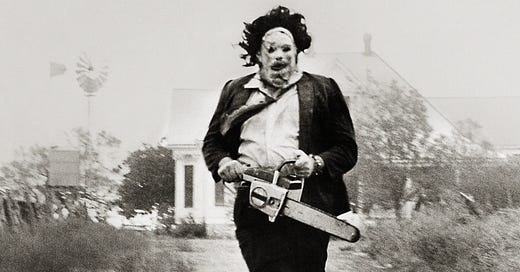















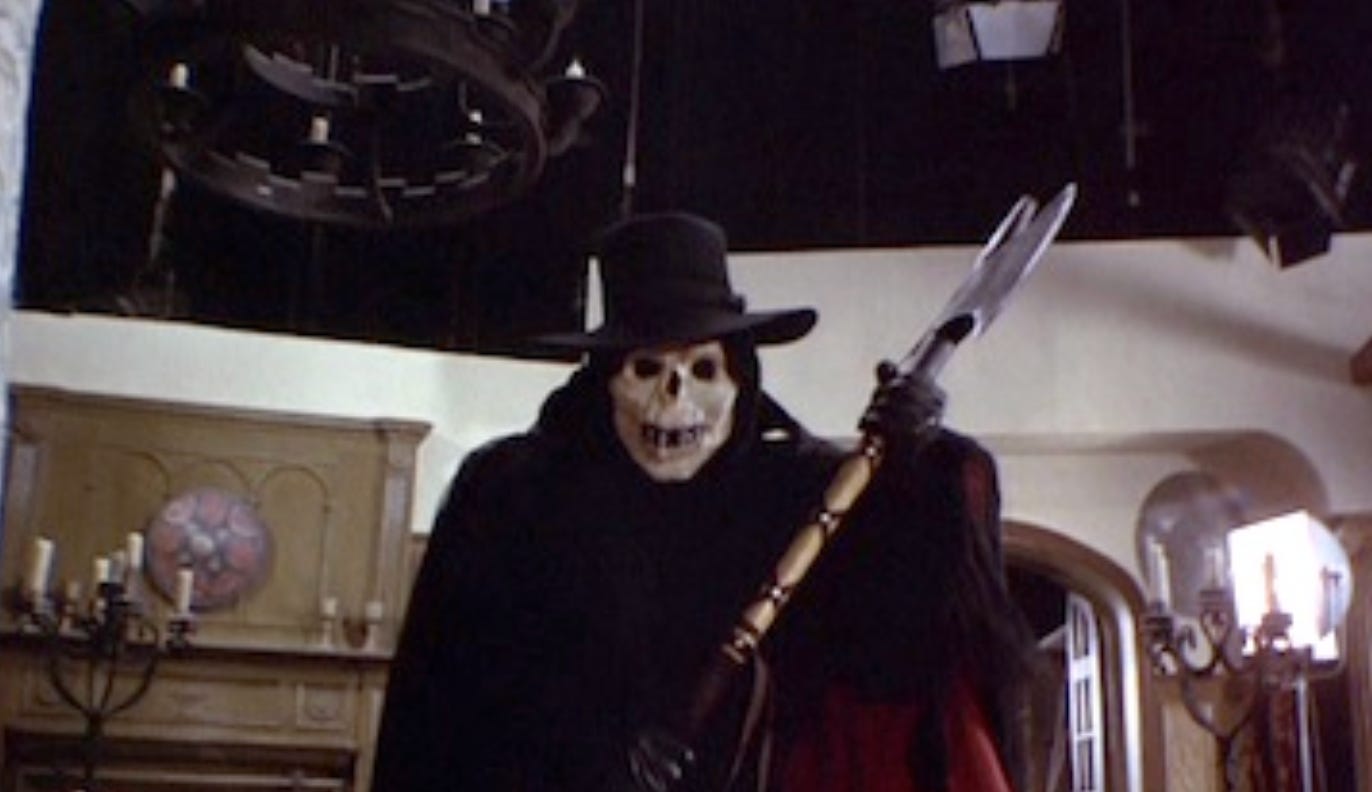

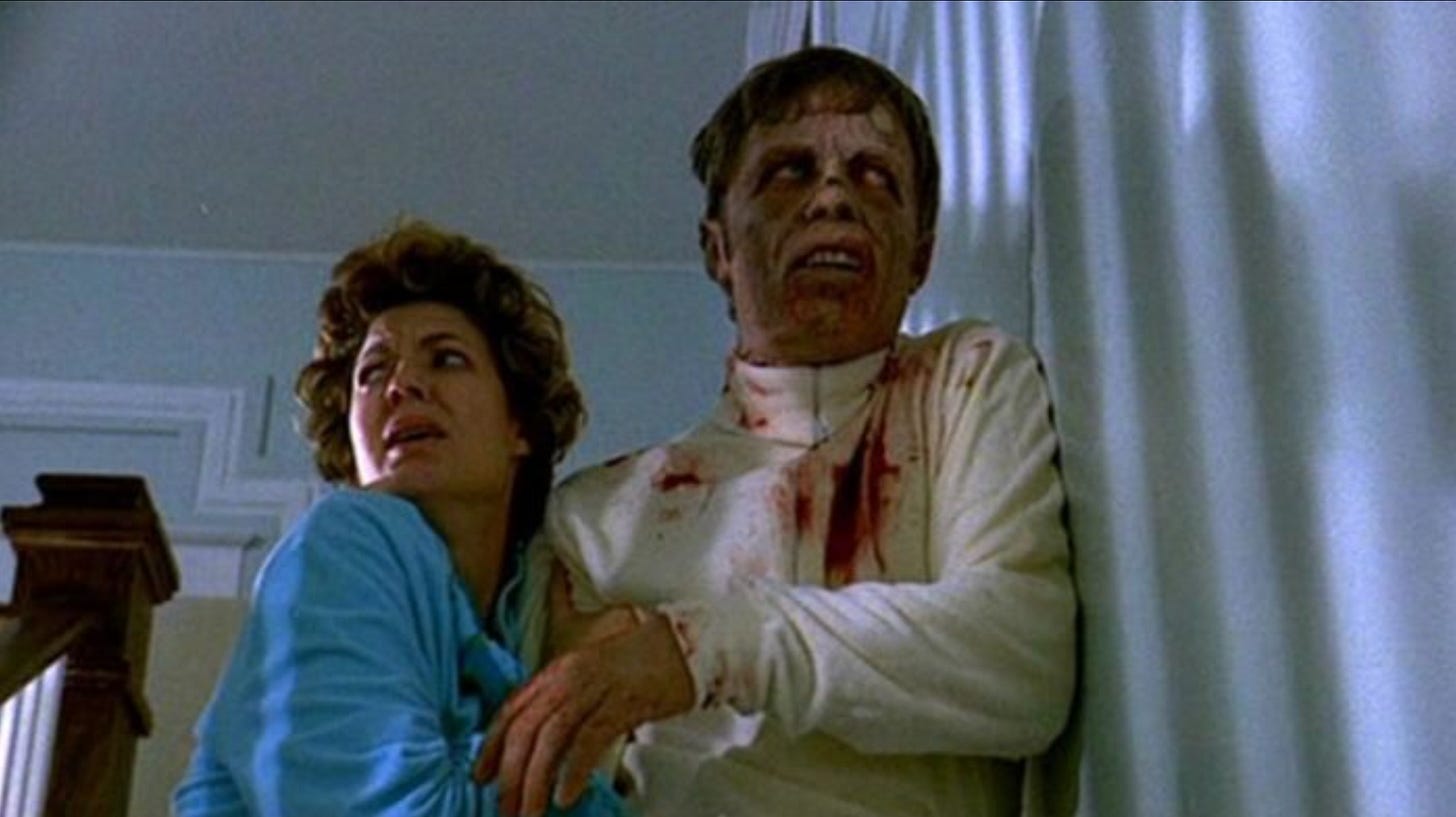




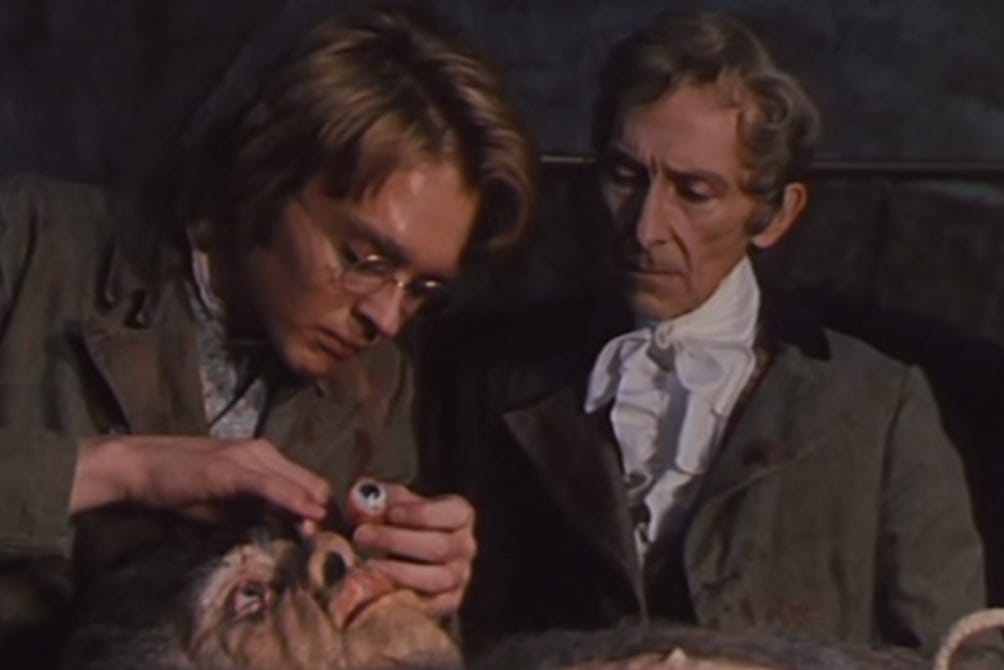












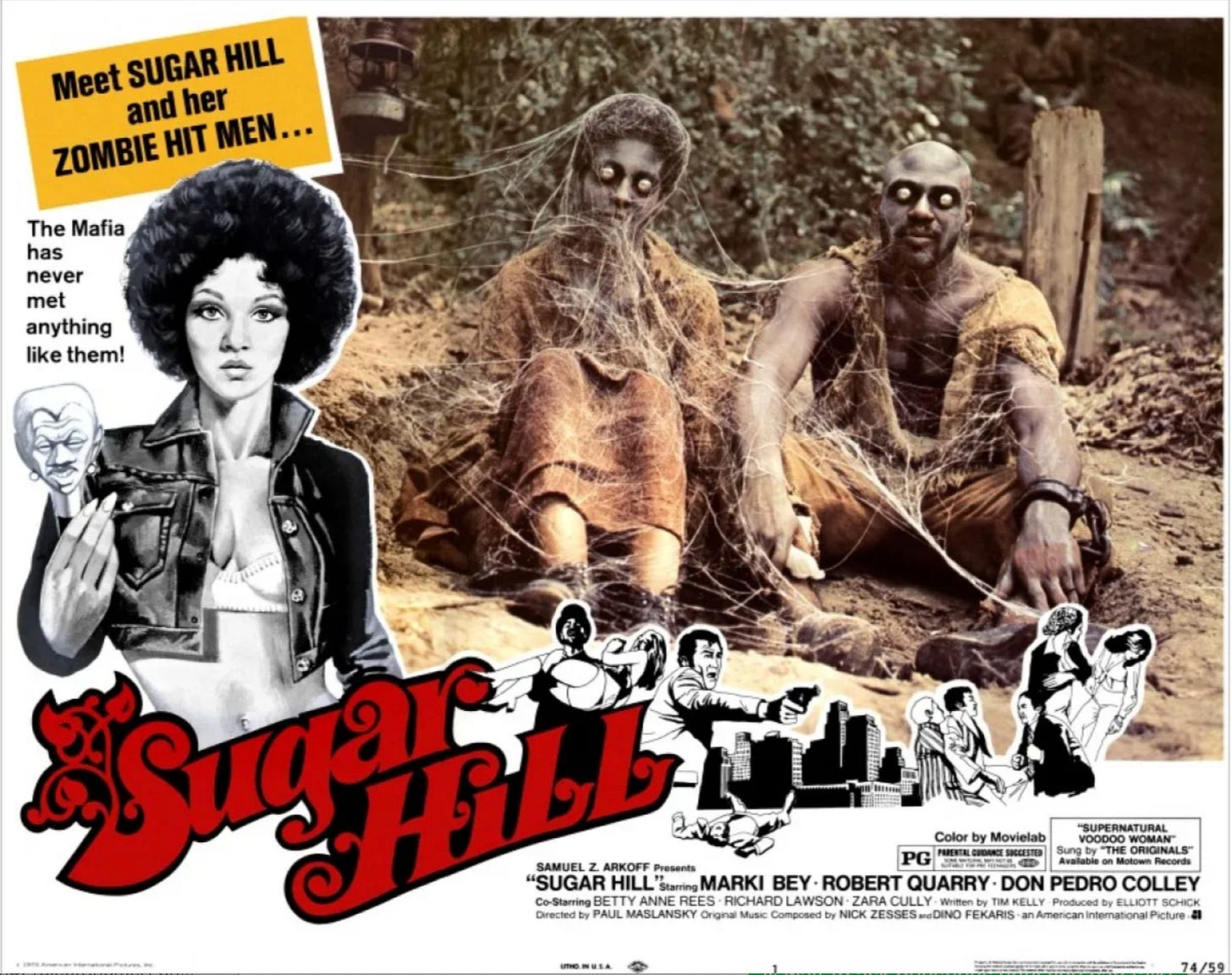

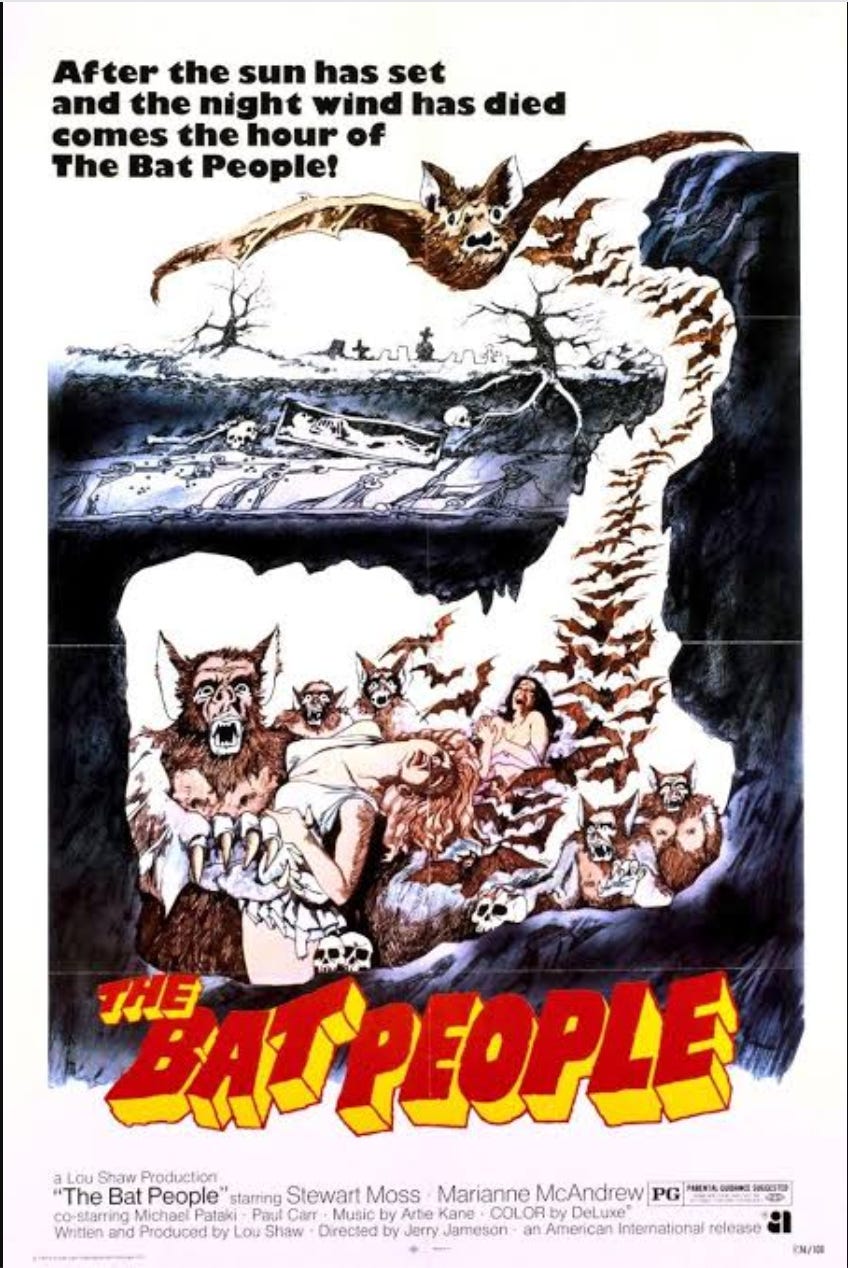

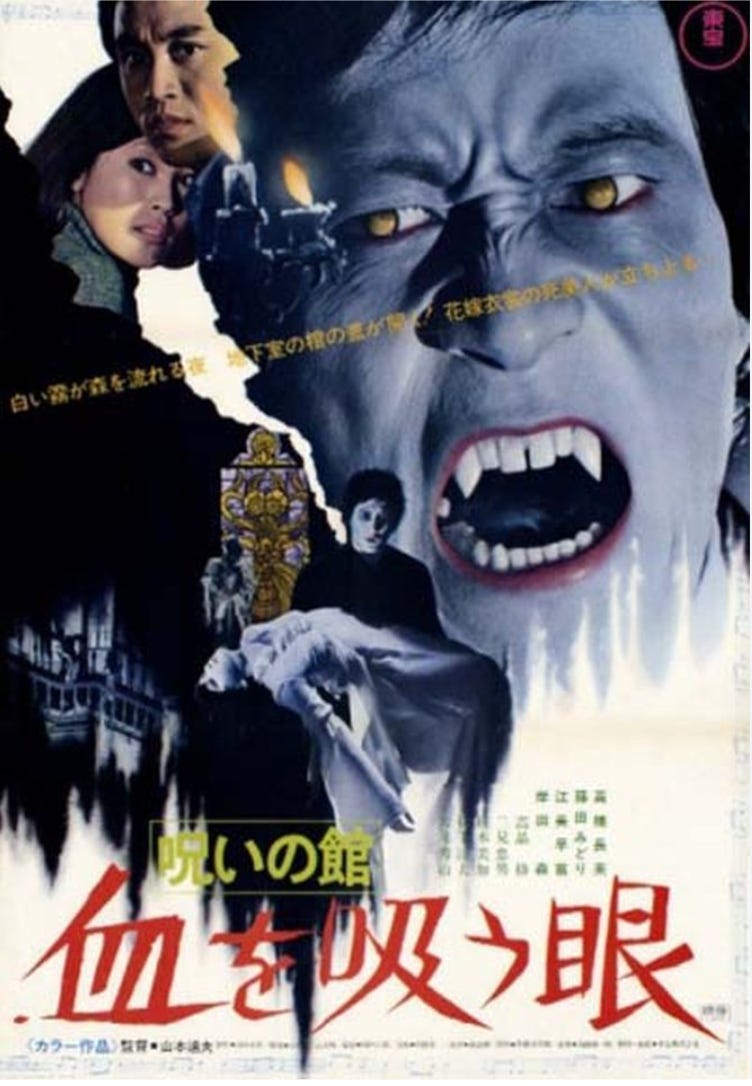


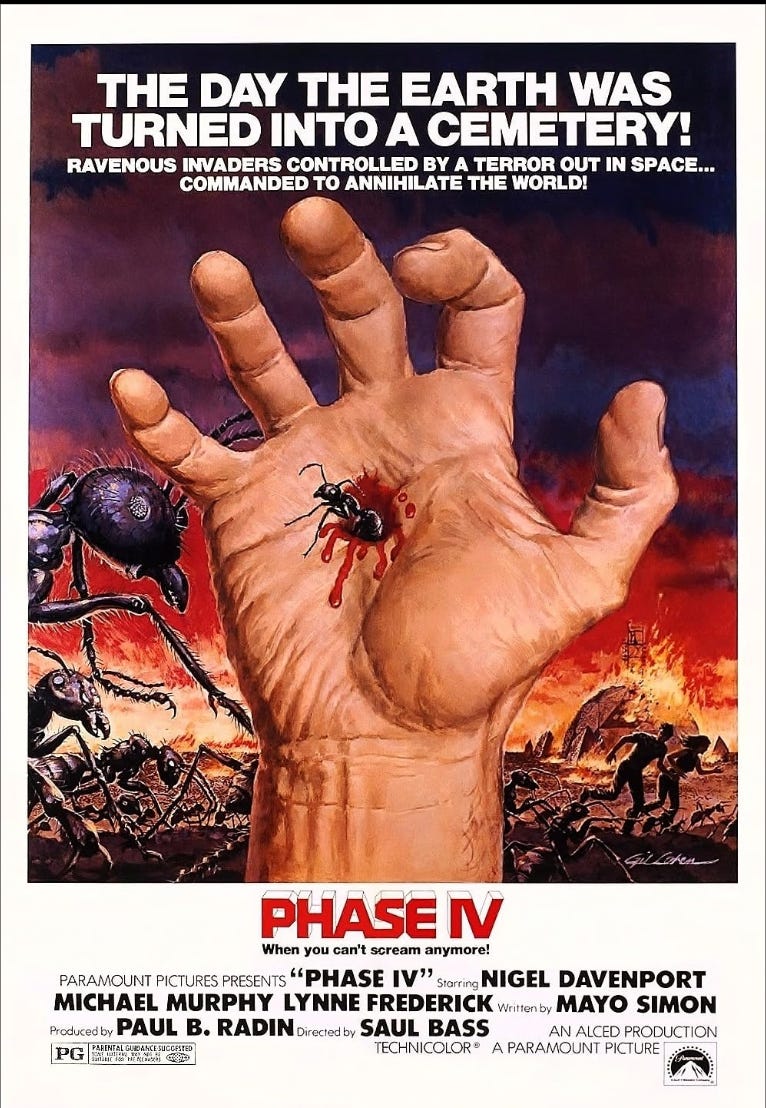

WOW! There are movie reviews, & there are EPIC movie reviews. I have lots of viewing to do after reading this most excellent horror offering. I agree that The Texas Chainsaw Massacre is one of the best horror films ever made. And speak of the devil, if you ever find yourself in the Austin area, I highly recommend you check out the restaurant linked below. The food is very good, but the atmosphere is something else. Re-watch the film before you go. 🤘😎🤘
https://austin.eater.com/2023/3/14/23638378/texas-chain-saw-massacre-restaurant-hoopers-kingsland-taco-flats
I don't participate in the Horror genre whatsoever, but I happily read through two-thirds of your post cuz I know you're enthusiastic and thorough. I realize it's a1979 film - and I wouldn't classify it as Horror - but regarding your point concerning blood-sucking as sex act - I adore Kinksi's penetration of Isabelle Adjani at the climax of Herzog's 'Nostferatu, Phantom der Nacht' (yeah, I prefer the German-language version). Kinski's sexual exhaustion at the end, so fantastic. *That's* one of my favorite films of all time, by - along with Bergman, my favorite movie-maker (what does' Gallo's Billy character repeat in "Buffalo '66"? (another all-time fave film of mine) something like "through all time!" - Werner Herzog.